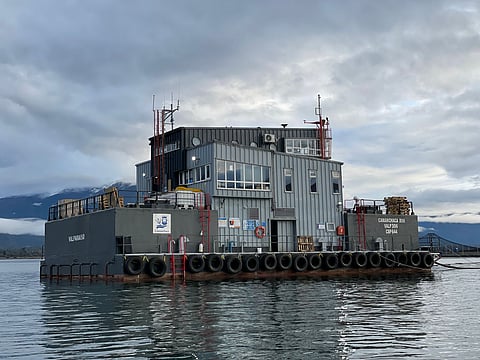

"Under normal environmental parameters, the business will perform better in the second half of the year," said vice-president Ricardo García Holtz.
Photo: Salmones Camanchaca.
Salmones Camanchaca opened its 2024 results with a weak Q1, which followed on the heels of a year - 2023 - in which the fishing division had saved the Group's revenues. Now, the Chilean company has published its results for Q2 2024 with revenues of USD 94.5 million (EUR 85.7 million), up 49% on the same period last year.
The result, said Salmones Camanchaca, is explained by the higher sales volumes achieved for both Atlantic and Coho salmon. Specifically, Atlantic sales were 61% higher than Q2 2023, reaching 11 thousand MT WFE. Meanwhile, in Coho, sales were 80% higher than last year. Given that the season ended in January, this led to a significant reduction in inventories.
This is undoubtedly positive news for the salmon company, which closed 2023 with a 14% increase in its harvest, but without a parallel rise in sales, which meant that the year ended with higher inventories, especially for Coho salmon, whose harvest in the last quarter of last year was 165% higher than that of 2022.
Thus, Q4 2023 saw harvests of 8,900 tons in Coho, while sales were only 1,100 tons, leaving ending inventory at year-end at 9,000 tons.
Another reason for the improved results of Salmones Camanchaca in Q2 2024 is the reduction of costs. According to the provided data, the quarterly production cost of Atlantic salmon harvested in the quarter was USD 4.64/kg (EUR 4.20/kg) live fish. This is 7% lower than recorded in the second quarter of 2023.
Higher revenues and lower costs generated a gross margin of USD 15 million (EUR 13.6 million) in Q2 2024, up to USD 10 million (EUR 9 million) from the same period of the previous year.
As a result, the Chilean salmon company's EBITDA for the period reached USD 14.7 million (EUR 13.3 million), a favorable result that more than triples that achieved in Q2 2023, which was USD 4.3 million (EUR 3.8 million).
Regarding harvests, as mentioned before, the Coho harvest was concluded in January, but the Atlantic salmon harvest result was 81% higher than in Q2 2023. The decision made in Q1 to delay harvest to gain weight and recover missing biomass caused by fish inappetence between October 2023 and February 2024 has paid off. In this second quarter the harvest weight was 5 kg WFE, up from 4.4 kg WFE in Q1 2024.
In addition, as Salmones Camanchaca pointed out in its release, there were no extraordinary massive mortalities in the period and, in recent years, a positive trend in biological and sustainability conditions was observed, with improvements in all indicators.
"During this second quarter the Company recovered biomass shortfall from the first quarter that was caused by an unusual lack of fish appetite, and this recovery allowed us to improve profitability with higher volumes and lower costs," explained Ricardo García Holtz, vice-president of Salmones Camanchaca. "That was decisive in facing a period of prices that continue to fall."
As a consequence of the above, the accumulated results of Salmones Camanchaca up to June 2024 reached revenues of USD 212 million (EUR 192.3 million). This is 19% higher than the same period of the previous year, with 22,693 MT WFE of Atlantic harvests, 13% higher than those of H1 2023. In terms of EBITDA, the first 6 months reached USD 19 million (EUR 17.2 million), 36% lower than in H1 2023.
Looking to the immediate future, García Holtz said that the company - which is already in the process of delisting from the Oslo Stock Exchange - is confident that, under normal environmental parameters, the business will perform better in the second half of the year when it expects to harvest approximately 5 to 6 thousand WFE tons more than in the first half of the year.
"And, concerning medium and long-term projections, we, like many, face government regulations adverse to the development of aquaculture; although we produce proteins with sustainability indicators far superior to the rest of the proteins and we do it amid a climate change that makes food security a global challenge, we have regulatory asphyxia," said the vice president of Salmones Camanchaca.
"It is unavoidable to give Chile a future vision of the role that aquaculture will play in the development and prosperity of the south of the country," concluded Ricardo García Holtz. Thus, the executive of Salmones Camanchaca was in line with what the Chilean salmon industry demanded in the recently held 'Salmon Summit 2024': a national vision for salmon farming.
